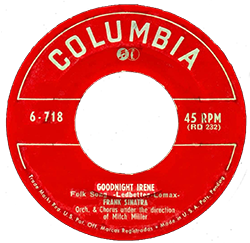The Life of a Song: ‘Goodnight, Irene’

Simply sign up to the Life & Arts myFT Digest -- delivered directly to your inbox.
It’s impossible to tell the story of “Goodnight, Irene” without telling the tale of Huddie Ledbetter. Born in 1888 (or possibly 1889) in Louisiana, Ledbetter was a man with a temper. He was jailed for murder in Texas in 1918, having killed a man in a fight over a woman. After seven years inside, he used his sweet singing voice and a specially composed ballad to charm the prison governor into granting him early release.
In 1934 he was back inside, this time in Angola prison, Louisiana, for his part in a knife fight, when the institution was visited by the folklorists John Lomax and his son, Alan. Struck by Ledbetter’s ringing tenor voice, and by what Alan Lomax later called his “panther-like grace and his extraordinary good looks”, the Lomaxes used their new portable recording equipment to immortalise for the Library of Congress the voice and 12-string guitar-playing of the man known to his fellow inmates — and to subsequent generations of music lovers — as Lead Belly.
The first song Lead Belly recorded for them was “Goodnight, Irene”, the waltzing lament of a married man gone astray. He told the Lomaxes he’d heard the song sung by his uncles as a child. They possibly knew it as “Irene, Good Night”, written in 1886 by Gussie Lord Davis, one of Tin Pan Alley’s first black songwriters. But the branches of this song’s family tree seem to spread far and wide. There are records of touring minstrel shows performing a song called “Irene, Goodnight” in the 1880s, while American folklorists in the early 20th century documented a verse in East Tennessee that turned up in “Goodnight, Irene” (the one about having a notion to “jump in the river and drown”).

Wherever the song came from, Lead Belly took possession of it and adapted it. On his release from Angola, he worked for a period for John Lomax as his driver and assistant. The Lomaxes helped Lead Belly to forge a career as a performer, setting up gigs at colleges and upscale functions attended mostly by white intellectuals and academics (suggestions that Lead Belly was ordered to wear prison stripes on stage by the Lomaxes have never been borne out). As his fame spread, some newspapers took a lurid interest in his back-story, labelling him the “homicidal harmoniser” and the “murderous minstrel”. “Goodnight, Irene” became his signature song in his performances until his death in 1949.
Meanwhile the American folk revival was hitting its stride and in 1950 The Weavers had a massive hit with “Goodnight, Irene”. But as it grew more popular, it became progressively, perhaps inevitably, more wholesome: “Goodnight, Irene, I’ll see you in my dreams,” The Weavers sang sweetly. Ditto Frank Sinatra in the same year.

Lead Belly had seen things differently, promising, “I’ll get you in my dreams”. And while in most versions the unhappy protagonist vows merely to “jump in the river and drown”, Lead Belly pledged additionally to “take morphine and die”.
Of the versions of the song that have explored its darker, morphine-clouded aspect, two stand out. Ry Cooder released a gorgeous Tex-Mex version in 1976, with the great Flaco Jiménez on accordion. And in 2002 Bryan Ferry, the consummate cover-version artist, included it on his Frantic album. With its mournful southern fiddle and funereal rhythm, Ferry’s version is chillingly bleak.
Cooder and Ferry’s versions also revived one of Lead Belly’s rarely sung verses, one that strips the song of all sentimentality:
I asked your mother for you,
She told me that you was too young.
I wish to the Lord I’d never seen your face
or heard your lying tongue.
For more in the series and podcasts with clips, visit ft.com/life-of-a-song
Photographs: Hulton Archive/Getty Images; Reuters
Letter in response to this article
Lead Belly sang ‘I’ll kiss you ’ in his signature song / From John Reynolds
Comments